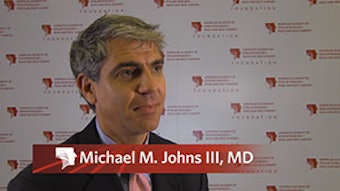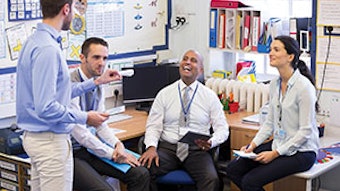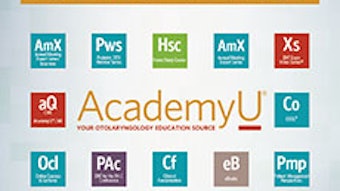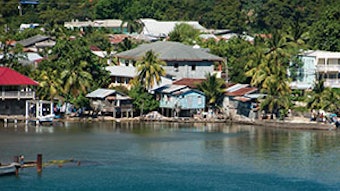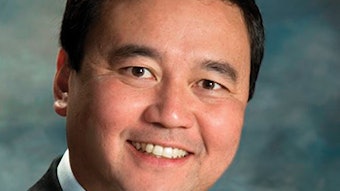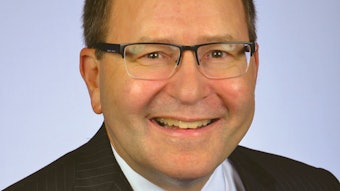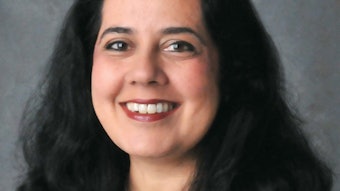FROM THE OREBM COMMITTEEPublications that may change your practice
In this Bulletin article, the Outcomes Research Evidence-Based Medicine (OREBM) Committee shares highlights from a recent key publication in otolaryngology-head and neck surgery. We offer concise summaries of significant findings that may alter current surgical practice.
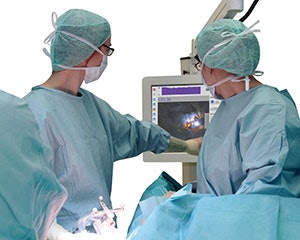
In this Bulletin article, the Outcomes Research Evidence-Based Medicine (OREBM) Committee shares highlights from a recent key publication in otolaryngology-head and neck surgery. We offer concise summaries of significant findings that may alter current surgical practice.
D’Cruz AK, Vaish R, Kapre N, et al. Elective versus therapeutic neck dissection in node-negative oral cancer. N Engl J Med. 2015 Aug 6;373(6):521-9.
This prospective, randomized-controlled trial compared elective neck dissection (END) to therapeutic neck dissection (TND) in patients with early-stage (T1-2), node-negative oral cavity squamous cell carcinoma (OSCC). Data from prior studies had been conflicting and thus a well-done, adequately powered RCT was warranted. END has shown therapeutic benefit in prior studies and provides pathologic staging, but 70 percent of ENDs are node-negative, prompting proponents of TND to raise concerns that END constitutes “over-treatment.”
Eligible patients were between the ages of 18 and 75 years with stage T1 or T2, lateralized OSCC. Patients’ primary tumor and lymph nodes were assessed using physical examination and ultrasonography (US) of the neck. After randomization, patients underwent excision of the primary tumor with adequate margins (≥5 mm). Patients in the END group underwent an ipsilateral selective neck dissection (levels I-III). In patients with metastatic nodal disease discovered during surgery (operative findings or frozen section), a modified neck dissection was performed with inclusion of levels IV and V. Patients in the TND group underwent the same primary tumor resection and were then monitored, with modified neck dissection (levels I to V) only at the time of nodal relapse. All patients who had positive nodes, a primary-tumor depth of invasion of 10 mm or more, or a positive resection margin received adjuvant radiation.
The findings were reported on the first 500 patients (245 in the END group and 255 in the TND group) who had completed at least nine months of follow-up. There were 50 deaths (20.6 percent) in the END group and 79 (31.2 percent) in the TND group. At three years, the corresponding overall survival rates were 80.0 percent and 67.5 percent, respectively (adjusted hazard ratio, 0.63; 95 percent CI, 0.44 to 0.90). There were 81 recurrences (33.3 percent) in the END group and 146 (57.7 percent) in the TND group. At three years, the corresponding rates of disease-free survival were 69.5 percent and 45.9 percent, respectively (adjusted hazard ratio, 0.44; 95 percent CI, 0.33 to 0.57). Of the 114 patients with cervical-lymph-node relapse in the therapeutic-surgery group, 60 (52.6 percent) died of disease progression. The majority of first events (114 events in 146 patients [78.1 percent]) were nodal relapses in the therapeutic-surgery group. Patients with nodal relapse presented with a more advanced nodal stage (p=0.005) and a higher incidence of extracapsular spread (p<0.001).
The major finding from this study is that END at the time of the primary tumor resection is associated with a significant overall and disease-free survival advantage (37 percent and 66 percent, respectively). Eight patients would need to be treated with END to prevent one death, and four patients would need to be treated to prevent one relapse. The strengths of this study include a prospective, randomized design and a large number of patients. Limitations include the use of ultrasound to detect nodal metastases, which is not as sensitive as other imaging, and the lack of data on treatment morbidity associated with neck dissection. The primary outcome did not focus on the impact of either T1/T2 status or depth of invasion, which were addressed in only subgroup and post-hoc analyses; understanding the impact of these key factors requires ongoing input from head and neck oncological experts and additional study. Although the authors demonstrate a survival advantage in the elective surgery group, the high rate of pathologically negative dissections in this group (70 percent) should not be ignored. Another issue is that the END group received more adjuvant radiation, which may explain the survival benefit. However, the important point is that END properly identified “high-risk” patients requiring more aggressive therapy. In this context, proven techniques such as sentinel-lymph-node biopsy or potential metastatic biomarkers could help identify subgroups requiring neck dissection and reduce patient morbidity while preserving the rate of disease control. Overall, these data help settle this decades-old debate regarding OSCC, and indicate that the neck should be addressed primarily even in early-stage lesions to maximize survival.
